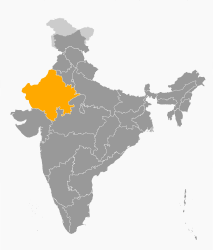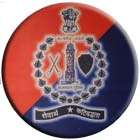Rajasthan Police
| Rajasthan Police Service राजस्थान पूलिस सेवा | |
|---|---|
| Abbreviation | Raj. Police |
|
Emblem of the Rajasthan Police | |
| Motto | Committed to serve ( सेवार्थ कटिबद्धता ) |
| Agency overview | |
| Superseding agency | Indian Police Service |
| Legal personality | Governmental: Government agency |
| Jurisdictional structure | |
| Operations jurisdiction* | State of Rajasthan, IN |
 | |
| Map of Rajasthan Police Department's jurisdiction | |
| Size | 342,239 km2 (132,139 sq mi) |
| Population | 73,529,325 (2015) |
| Governing body | Government of Rajasthan |
| General nature | |
| Operational structure | |
| Headquarters | Jaipur |
| Agency executive | Sh. Ajit Singh Shekhawat, IPS[1], Director General of Police, Rajasthan State |
| Website | |
|
police | |
| Footnotes | |
| * Divisional agency: Division of the country, over which the agency has usual operational jurisdiction. | |
The Rajasthan Police is the law enforcement agency for the state of Rajasthan in India. The Rajasthan Police has its headquarters in Jaipur, the state capital. The motto of the force is सेवार्थ कटिबद्धता, which means "committed to serve".[2]
History
Rajasthan was formed by the merger of the erstwhile princely states. The security and the police forces of the former princely states varied in composition, functions and administrative procedures. Following the merger, the police forces of the princely states united as of January, 1951.[3]
Present scenario
As of 2014 the Rajasthan Police employed 82,193.[4] Over the years Rajasthan Police has firmly and professionally dealt with bandits (dacoits) in the Chambal ravines, organised crime, spies, smugglers, narco-terrorists and subversive elements from across the 1,040 kilometres (650 mi) long border with Pakistan. The Rajasthan Police is headed by the Director General of Police (DGP). Rajasthan is divided into 2 police commissionerate, 7 police range each headed by an Inspector General of Police (IGP). The state is further divided into 40 districts (including 3 rural districts, 2 city districts in Jaipur City and 2 railway police districts), 171 circles, 709 police stations and 788 out-posts. The force had 889 Inspectors, 3366 Sub-Inspectors, 3902 Asstt. Sub-Inspectors, 8867 Head Constables and 52837 Constables and about 700 Indian Police Service (IPS) and Rajasthan Police Service (RPS) officers.
Recruitment and service
Recruitment is generally through the Rajasthan Public Service Commission (RPSC), which conducts a state-level examination called Rajasthan Administrative Service/Sub-ordinate Services Exam (RAS). After passing the exam, recruits undergo training at RPA Jaipur and RPTC. They are governed by Rajasthan Service Rules. The nine organisational units are Crime branch, Rajasthan Armed Constabulary (RAC), State Special Branch, Anti Terrorist Squad (ATS), Planning and Welfare, Training, Forensic Science laboratory, Telecommunications and Traffic Police.
Rajasthan Armed Constabulary
RAC Rajasthan Armed Constabulary Soon after Independence, the law and order situation along the 1070 km Indo-Pak border became a serious problem. Incursions and cattle lifting by Pakistani raiders was a regular feature and it became imperative to put an end to it. In 1949-50, the duty of guarding the border was handed over to the joint forces of the Central Reserve Police and the Provincial Armed Constabulary, which continued until 1952. In 1952, the Government of Rajasthan decided to raise a special force that could not only be deployed along the border but also assist the civil police in combating the dacoity menace. The first headquarters and training centre was established at Bharatpur in 1952 and five battalions received training there. These men, some ex-soldiers drawn from the State forces and some from places outside Rajasthan, were a part of the first 5 battalions of the Rajasthan Armed Constabulary. Each battalion consisted of 6 companies and one company remained at the battalion headquarters. These battalions were then dispatched to the border areas of Sriganganagar, Raisinghnagar, Barmer, and Jaisalmer. One unit was stationed at Ghat Gate, Jaipur to check dacoity. Within a year of its inception, the RAC proved its worth both on the border and within the State by successfully carrying out its various duties. The members of RAC displayed gallantry and high sense of morale on occasions that required courage, perseverance, and devotion to duty. Its men battled against all odds, combating not only the enemy but also facing the rigours of the desert areas devoid even of the bare necessities of life. The RAC continued as a temporary force until 1958, there after it was made permanent. From that year up to the late 1970s more battalions of RAC were raised as per the situation and the need. India saw two wars with Pakistan and one with China and there was unrest in Jammu and Kashmir, NEFA, as well as Mizoram. RAC battalions were dispatched to these sensitive areas and earned accolades for their courage and efficiency. In 1962, two companies were taken out of each unit and the 6th Battalion was formed. More battalions followed in the subsequent years. Later, seven of these RAC battalions were merged with the Border Security Force and two with the Central Reserve Police Force. Over a period of time, increasing criminal tendencies, subversive political activities, communalism and violence, have all led to the worsening of the law and order situation all over the country. Rajasthan could not remain unaffected. Hence, the need was felt to create a special task force, familiar with modern techniques necessary to deal effectively with communal disturbances. In 1998, a Special Task Force, along the lines of the Rapid Action Force of C.R.P.F., was formed to maintain peace in the sensitive districts of Rajasthan. These companies are trained and fully equipped to handle riots. The training imparted to the select RAC companies is decided as per requirements. There are 3 companies of RAC, which have drawn expert swimmers from various R.A.C. battalions and are being trained for flood relief work. The Sixty seven years of RAC’s existence have been full of legendary stories, of heroic encounters, of gallant men and their dare devilry. One story that is still related with considerable pride is about the unforgettable encounter with dacoits in Thor village of Dholpur - it lasted for 18 hours. The outcome? thirteen dacoits held and no casualties on the RAC side. As on today fifteen battalions of RAC including one special battalion formed by only Ladies Constables Specially trained Unit named Hadi Rani Mahila Battalian and one battalion of MBC are there in the State as Statepara-military force. Out of these 14 battalions of RAC, 11 battalions are deployed in Rajasthan while 3 in Delhi.
Rajasthan Armed Constabulary
All units
- First Battalion-Jodhpur
- Second Battalion- Kota
- Third Battalion-Bikaner
- Fourth Battalion-Jaipur
- Fifth Battalion-Jaipur
- Sixth Battalion-Dholpur
- Seventh Battalion-Bharatpur
- Eighth Battalion-Delhi
- Ninth Battalion-Tonk
- Tenth Battalion-Bikaner
- Eleventh Battalion-Delhi
- Twelfth Battalion-Delhi
- Thirteenth Battalion-Jail Security
- Fourteenth Battalion-Bharatpur
Most Wanted Criminal
Below are the list of most wanted Criminal in Rajasthan police record.
- Lawrence Bishnoi- Under Section of 302, 307, 420, 751, 195 Hanumangarh
- Samarjeet Singh Mann, Under Section of 302, 307, 751 Sri Ganganagar
- Ehsaan Ahmed, Under Section of 302, 307, 420, 751, 195 Ajmer
Mewar Bhil Corps
In the second half of the 18th century, the hilly region of Rajasthan comprising Mewar, Dungarpur, Banswara, and Pratapgarh, was in a state of perpetual disorder. Weak administration and undisciplined armies could not control the criminal activities of the Bhils of this hilly region. During the first half of the 19th century the number of murders and robberies increased to an alarming extent. The British political agents proposed the setting up of a special force that could tackle this problem. Initially, the force deployed consisted of army officers drawn from the native infantry but that too proved ineffective. Then, in 1837, Col. James Outram, the political agent of Mahikanta, proposed the establishment of a Bhil corps under the command of a British officer. This policy of recruiting local people for helping in the maintenance of order among their own people was a successful experiment. Initially the Mewar Bhil Corps was funded by the rulers of Mewar, Pratapgarh, Dungarpur and Banswara, but before long, the finance and administration was taken over totally by the British Indian Army. Other than Bhils, efforts were made to enlist the Garasias and Gametis into MBC. By 1841, the entire hilly tracts of Mewar were put under the supervision of the commandant of the corps. This had a beneficial effect on the law and order situation in the southern region and there was a fair state of discipline. The MBC remained a regular unit of the Indian Army until 1938, but was transferred to Rajasthan Police in 1950. They were allowed to discharge the same duties and functions, which they did prior to the separation. Uniform pay scales introduced by the government were also made applicable to them subsequently, bringing them on par with other members of the Rajasthan Police. The sole battalion of M.B.C. are deployed in Udaipur Range.
References
- ↑ http://www.police.rajasthan.gov.in/Rajpolice/dgpMsg.aspx
- ↑ http://www.police.rajasthan.gov.in/Rajpolice/Missionstatement.aspx
- ↑ http://www.police.rajasthan.gov.in/Rajpolice/History.aspx
- ↑ "Crime in Rajasthan 2014" (PDF). police.rajasthan.gov.in. State Crime Records Bureau, Rajasthan, Jaipur. Retrieved 5 April 2016.


